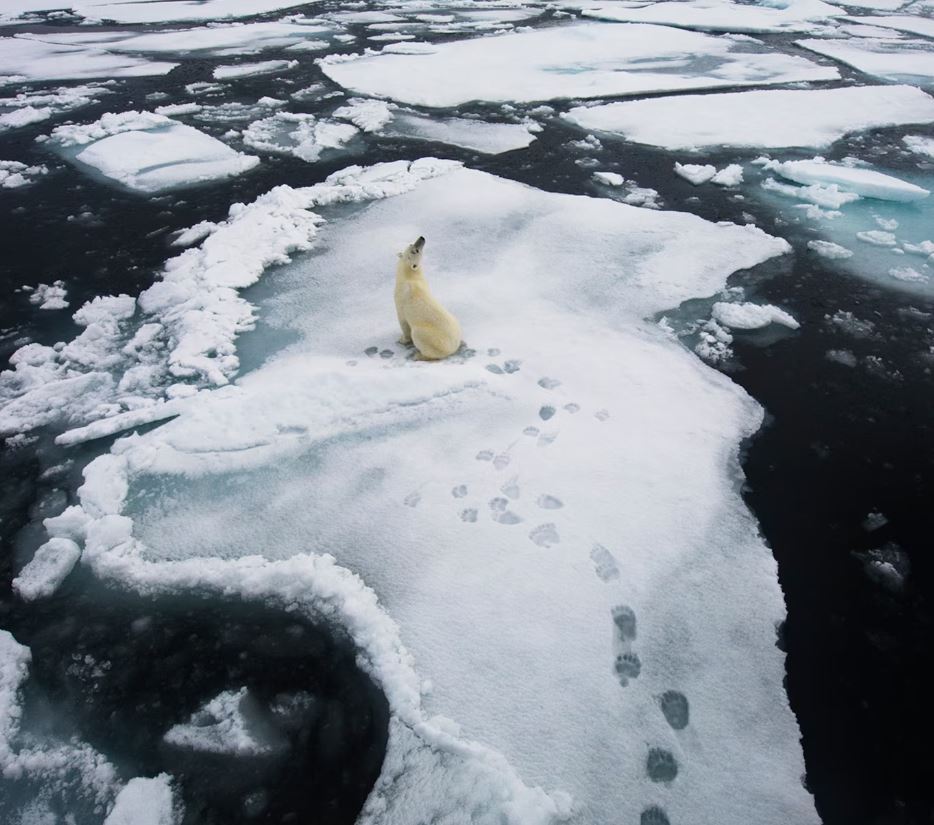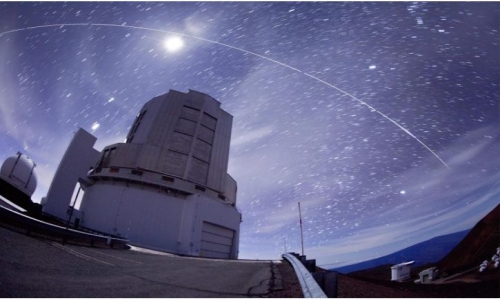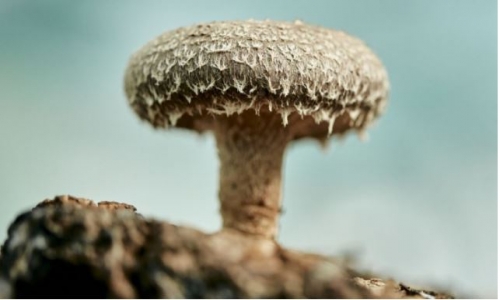


 12:39:0
12:39:0  2024-11-19
2024-11-19  1143
1143

Polar bears walk across sea ice for miles, searching for cracks and holes in the surface through which they can hunt their ringed seal prey. But a new study has found that, in some areas, the ice on which they rely has been damaging their feet.
Writing in the journal Ecology, ecologist Kristin Laidre of the University of Washington and wildlife biologist Stephen Atkinson of the Nunavut Department of the Environment found that bears in two of the most northerly populations—East Greenland and Kane Basin, between northeastern Canada and northwestern Greenland—had suffered lacerations, hair loss, skin ulcerations, and ice build-up on their fur and primarily on their feet.
In the most extreme examples, two bears had ice blocks up to one foot in diameter stuck to their foot pads, which caused deep, bleeding cuts and made it difficult for them to walk.
Atkinson first noticed lesions in bears in Kane Basin during a survey in the region in 2012 and 2013. He shared images with Laidre but didn’t yet know it was part of a trend. “We didn’t really know what to think of it,” she says.
Then, during surveys of East Greenland between 2018 and 2022, Laidre began seeing the same injuries. The reason, the study’s authors believe, is climate change, and they’re concerned it could become yet another challenge for polar bears to adapt to.
Some bears had alopecia, or hair loss, on their bodies, presumably where balls of ice had become entangled in their fur and been ripped out. Laidre notes that, by itself, that isn’t necessarily uncommon.
“Polar bears live in extreme environments where they can get ice buildup,” she says.
What made it notable, however, was the context, with most of the incidents of alopecia occurring on bears’ feet. Many of the polar bear paws they examined also displayed other, serious wounds, including multiple bleeding ulcerations. They suspect the wounds were painful because the bears sometimes flinched when the wounds were gently touched, even though they were sedated.
Finding bears with ice blocks on the soles of their feet was, says Laidre, “totally shocking.”
From the air, she could tell that “Something was wrong with them because it appeared they couldn't walk very well. It wasn't until I was on the ground that I realized of course they couldn’t walk, when I saw what was stuck to their feet.”
When she sedated the bears and examined their paws, she found that the blocks of ice were solid. It took 30 minutes of scraping away with metal tools to remove them.
The total number of bears with some form of ice-related injury that Laidre and Atkinson identified between them was relatively small—32 in Kane Basin and 15 in Eastern Greenland. But that constituted 52 percent and 12 percent of the all the bears that were studied— which is notable given that, Laidre says, such impacts had not previously been noted by scientists or by Indigenous hunters, who were also interviewed for the study.
“We didn't want to say this is something new without hearing what hunters had observed,” Laidre explains. “The people who see polar bears the most are the people who live in communities alongside bears and hunt for subsistence, and most of the hunters we spoke to had not seen this before.”
Many did note, however, that they had seen something similar with their sled dogs, which sometimes also experienced painful ice build-up on their paws in slushy conditions.
“Polar bears with ice balls have been observed in many parts of the Arctic, but the recent observations are much more severe and larger,” ecologist Andrew Derocher of the University of Alberta, who was not involved with the study, told National Geographic. “It's common for polar bears to get ice balls on their backs from swimming when conditions are cold. Ice balls on polar bear feet are much less common and some unusual conditions are needed for them to occur.”
Laidre and Atkinson believe that a warming climate may have played a role; in their paper, they propose explanations for the injuries.
Firstly, they note that as temperatures increase in the Arctic, precipitation is increasingly falling as rain instead of snow, and one scenario they envisage is rainfall causing a slushy surface on the ice, which then freezes on the paws of polar bears that walk through it. Additionally, warming causes surface snow to melt and refreeze into a hard crust, and a second possibility is that bears’ paws break through that crust and become cut on the sharp edges.
A third scenario helps explain why bears in these populations— and so far only these two populations—have been observed with these injuries.
Laidre notes that during springtime, many Kane Basin and East Greenland bears live on landfast ice—extensive ice sheets that are attached to the shore—or at the foot of glaciers. Warming in these environments leads to thinner sea ice, allowing seawater to seep up into the snow and create a slushy surface.
Bears living in more southern regions have access to (relatively) warmer water to wash off chunks of ice, but because these bears live at very high latitudes where conditions are generally much drier and colder, they have much less access to open water than bears farther south.
“As polar bears are well-adapted to their Arctic habitat, they must have been experiencing unusual conditions for this ice buildup to occur— such as rain when it should be snowing, or temperatures above freezing when it should be cold,” says John Whiteman, chief research scientist for Polar Bears International.
“It is striking that this problem affected multiple bears in the study area," he adds. "This pattern, plus the observation that severe injuries in some bears seemed unlikely to heal on their own and were associated with lame gaits, suggests that ice clumps could become a meaningful problem for polar bears on a wider scale."
But ice clumps have yet to be observed in other regions, so the long term threat to polar bears remains uncertain.
“The Arctic is changing rapidly as the climate warms and polar bear scientists are watching how the bears respond,” says the University of Alberta’s Derocher. “There are lots of surprises in polar bear behavior. Sometimes, it seems that the bears have figured out a way to survive in a warming Arctic but then something odd like these massive ice balls show up and suggest that they're having troubles that nobody had thought possible.”
Reality Of Islam |
|

This is the

A computer

Auburn Univ

Poisoning i
 9:3:43
9:3:43
 2018-11-05
2018-11-05
10 benefits of Marriage in Islam
 7:5:22
7:5:22
 2019-04-08
2019-04-08
benefits of reciting surat yunus, hud &
 9:45:7
9:45:7
 2018-12-24
2018-12-24
advantages & disadvantages of divorce
 11:35:12
11:35:12
 2018-06-10
2018-06-10
 6:0:51
6:0:51
 2018-10-16
2018-10-16
al-hussain (peace be upon him)
 10:18:1
10:18:1
 2022-09-21
2022-09-21
 2:11:12
2:11:12
 2022-10-15
2022-10-15
 10:47:11
10:47:11
 2022-11-22
2022-11-22
a hero waters thirsty wild animals
 9:4:9
9:4:9
 2022-01-06
2022-01-06
 1:38:41
1:38:41
 2021-12-08
2021-12-08
 12:10:56
12:10:56
 2022-11-17
2022-11-17
 11:34:48
11:34:48
 2022-06-29
2022-06-29
 5:41:46
5:41:46
 2023-03-18
2023-03-18
| LATEST |